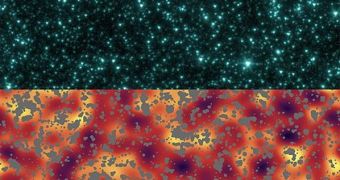Scientists with the Institute of Astronomy in Cambridge announce the discovery of very old stars inside the earliest galaxies known to have formed in the Universe. The discovery seems to hint that the galaxies themselves are in reality a lot older than first estimated.
Team leader Dan Stark says that some of the oldest stars in the Universe are 13.5 billion years old, which means that they must have formed only 200 million years after the Big Bang. However, not all current theories explaining the Cosmos permit this phenomenon.
This is not the first time that experts propose a reclassification of galactic ages. The IAC study basically provided additional evidence to the existing ones. When taking this into account, the need for more advanced telescopes capable of peering back to the beginning of time becomes even greater.
At this point, astronomers are not sure whether the theories developed to explain the Cosmos are wrong or incomplete, or if the technology we currently have access to is simply incapable of peering so far back in time, to the earliest days of the Universe.
“It seems probable that there are in fact far more galaxies out there in the early Universe than we previously estimated – it's just that many galaxies are older and fainter, like the one we have just discovered,” Space Astronomy Laboratory astronomer and study coauthor Jean-Paul Kneib explains.
Before the study that identified the oldest known star, the previous record was held by a cosmic fireball that formed about 480 million years after the Big Bang, Daily Galaxy reports. Astronomers are currently conducting follow-up studies on both researches, in order to ensure data accuracy.
The recent finding “challenges theories of how soon galaxies formed and evolved in the first years of the Universe. It could even help solve the mystery of how the hydrogen fog that filled the early Universe was cleared,” Lyon Observatory expert and lead study author Johan Richard adds.
“If this unseen army of faint, elderly galaxies is indeed out there, they could provide the missing radiation that made the Universe transparent to ultraviolet light,” he goes on to explain.
When the NASA/ESA/CSA James Webb Space Telescope (JWST) enters service – no early than 2018 – its sensitive instruments will enable astronomers to peer back in cosmic history, all the way to the first light sources.
At that time, astrophysicists will have access to more data on this issue, and will be able to develop or amend theories to explain early stellar formation.

 14 DAY TRIAL //
14 DAY TRIAL //